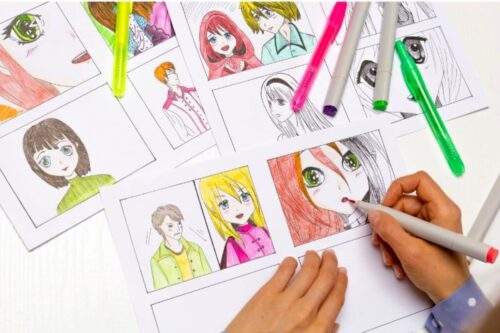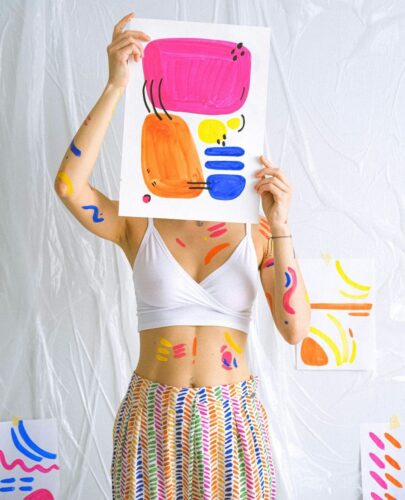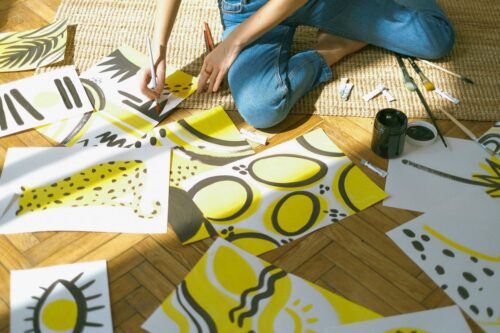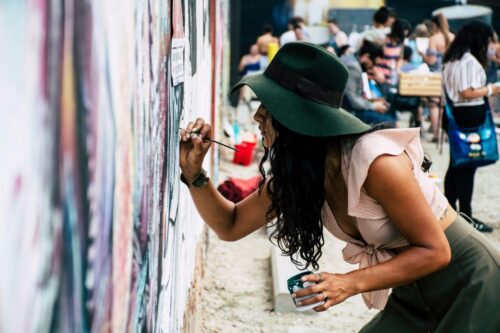How Creative Minds Are Redefining Cartooning Art Into Autism World
 For many individuals on the autism spectrum, expressing inner thoughts, emotions, and perspectives through traditional writing and communication methods can be immensely challenging. The inherent rules, implied contexts, ambiguities, and social conventions of written and spoken language don’t always align with the neurodivergent mind. Words on a page or spoken aloud often feel inadequate for conveying authentic selves and creative minds.
For many individuals on the autism spectrum, expressing inner thoughts, emotions, and perspectives through traditional writing and communication methods can be immensely challenging. The inherent rules, implied contexts, ambiguities, and social conventions of written and spoken language don’t always align with the neurodivergent mind. Words on a page or spoken aloud often feel inadequate for conveying authentic selves and creative minds.
This disconnection from verbal and written expression can lead to feelings of isolation, frustration, and restraint for people with autism spectrum disorder (ASD). Cartooning art offers an empowering alternative that celebrates visual communication and personal creativity. This unique storytelling medium has opened new vistas of self-expression for many on the spectrum.
What is Cartooning Art?
At its core, cartooning art is a form of visual storytelling that uses simplified drawings, caricatures, and illustrations to depict narratives, perspectives, emotions, and ideas. Rather than being bound by written words, the cartoonist crafts entire worlds using only pencil or pen on paper (or digital equivalents).
This directness and lack of linguistic constraints or cues can be incredibly liberating for those with autism. The cartoonist has total control over their illustrated universe, able to create scenes precisely as they envision them internally. There is no subtext to decipher, no ambiguities of language to resolve. The meaning is spelled out plainly in the drawings themselves.
Cartooning also encourages succinct, “stripped down” visual communication void of excessive detail. This creative outlet style of simplicity and focus on core ideas and imagery avoids potential sensory overload from too much linguistic or environmental information. In this sense, cartooning offers a way to focus the mind.
How the Cartoon World Aligns with Autism and Creative Minds
In many ways, the art of cartooning naturally aligns with the cognitive strengths associated with autism spectrum disorder:
- Intense Focus and Attention to Detail: The ability to sustain intense focus on specific subjects of interest for long periods is a hallmark of autism. Many individuals with ASD have a remarkable eye for detail and patterns. In cartooning, these traits serve the artist well, allowing for the rendering of intricate illustrations down to the finest points.

- Visual Thinking and Processing: Research suggests the brains of people on the spectrum are often wired more for processing visual and spatial information rather than verbal and auditory input. As cartooning is an inherently visual medium, this creative outlet may fit like a glove. Translating an abstract idea or inner experience into a concrete image could feel like second nature.
- Systematic Approach: Successful cartoon art often adheres to overarching structures, systems, and consistent rules, from repeatable character designs to panel layouts and visual storytelling techniques. This systematic nature, when combined with attention to detail, allows for the creation of immersive, cohesive illustrated worlds. The comfort that can come from reliable processes and defined frameworks may aid the creative flow.
- Expressing the “Inexpressible”: While articulating an inner emotional state, personal truth, or perspective through written or spoken words can be enormously difficult for some with autism, representing that same inner world through intentional drawing and visual metaphors makes it concrete and shareable. The cartoonist externalizes their mind.
- Freedom from Social Conventions: Social communication in the real world requires constantly navigating a complex web of implied contexts, cultural cues, unspoken rules, and societal norms. Pragmatic language skills that many take for granted do not come automatically for those on the spectrum. In the cartoon world, the creator becomes the author of a new world exempt from these constraints. Their vision is the only one that matters on paper.
Discovering a Powerful Creative Outlet Through Cartooning Art
Perhaps most importantly, cartooning provides a sanctioned creative outlet with no singular “right” way for self-expression. The cartoonist is the sole author of their work and its ultimate meaning.
No matter how eccentric or outlandish a cartoon may seem to a neurotypical viewer, there are no societal expectations to meet beyond applying oneself fully to the craft itself. This freedom of creative expression holds huge significance for many on the autism spectrum who may feel confined by neurotypical societal norms and assumptions.
The late autistic author and cultural philosopher Dr. Olga Bogdashina wrote, “The world perceived by an autistic person is completely different than the one perceived by a non-autistic person…Autistic individuals do not share the neurotypical ability to see shared contexts and understand implicit meanings that are not explicitly stated.”
With cartooning, the individual creates their explicit context and meaning, shared or not.
The Undeniable Appeal of Cartooning Art
Likely for these reasons and more, cartooning and comic illustration have undeniably appealed to many revered artists and writers on the autism spectrum. The autobiographical work of creators like Lynda Barry, John Hendrix, Jim Woodring, and Raina Telgemeier has offered poignant windows into their neurodivergent experiences.
In “Fun Home,” Alison Bechdel pioneered autobiographical adult cartooning by depicting her childhood struggles with sexual orientation and her closeted gay father. Justin Green’s “Binky Brown” comics detailed his battles with obsessive-compulsive disorder and intrusive thoughts. David B.’s abstract graphic memoir “Epileptic” captured his experiences with his epileptic brother in evocative, dreamlike imagery.
These deeply personal works demonstrate the unique power of cartooning to depict intangible thoughts, sensory experiences, and internal mindscapes in disarmingly relatable visuals. What might read as impenetrably abstract described through written words alone takes on profound meaning and emotional truth through metaphors and illustrations.
Rising Interest and Opportunities in the Cartoon World
 As societal understanding, embracement, and accommodation of autism grow, so too does interest in supporting and teaching cartooning for creativity, communication, and cognitive expression. An increasing number of dedicated comics art courses, tools, and resources tailored specifically for learners on the spectrum are emerging.
As societal understanding, embracement, and accommodation of autism grow, so too does interest in supporting and teaching cartooning for creativity, communication, and cognitive expression. An increasing number of dedicated comics art courses, tools, and resources tailored specifically for learners on the spectrum are emerging.
For example, the British Cartoonists’ Association partnered with a therapy center to offer specialized cartooning classes for children and adults with autism. These classes provide structured creative outlets as well as community-building opportunities and skill development.
The courses are led by instructors trained in techniques to make the experience as supportive and accessible as possible for students with ASD.
Similarly, graphic narrative projects and school comics clubs are springing up globally to nurture creative storytelling through the medium while celebrating neurodivergent talents. From the U.S. and Canada to Australia and beyond, these inclusive environments aim to provide autistic artists the space for open-ended visual expression as a creative outlet, liberated from constraints.
Even assistive tools and technologies are emerging to empower cartooning and graphic storytelling for the ASD community. Apps, digital art assets, and specialized software offer tailored solutions to common barriers and facilitate every phase of the creative process, from freeform sketching to panel layout and narrative structure.
Opening Creative Minds Through Cartooning Art
As more opportunities become available for people on the autism spectrum to share their experiences and imaginations through the powerful creative art form of cartooning, the world stands to gain profound new perspectives.
Given this creative liberation to visually represent their inner worlds, the unique cognitive strengths and candid insights of autistic creators will enlighten our universal understanding. Their uninhibited ability to depict thoughts and perceptions in new ways will expose the boundaries of conventional norms.
From sequential metaphors that render the inexpressible concrete to the hyper-focused detail and consistency that immerses readers in rich, self-contained realities – autism and cartooning is proving to be a remarkably pairing capable of shedding new light on human experience itself.
Pushing the Boundaries of Storytelling through the Cartoon World
Some of the most exciting artistic innovations today are emerging from autistic comic creators embracing and celebrating their neurodivergent perspectives. By disregarding conventional storytelling norms, these visionary artists are expanding the boundaries of what comics can achieve as a medium.
Take for instance the work of Taiwanese comic artist Xaviant Xu. Her highly stylized, avant-garde graphic novel “Avoiding the Void” dispenses entirely with linear narratives, panels, and speech bubbles. Instead, the book uses kaleidoscopic abstractions of line and color to depict the formless anxieties and sensory experiences of an agoraphobic narrator.
While utterly unconventional, Xu’s stream-of-consciousness visual poetry captures something profound about the nature of fear, introversion, and dissociation that eludes traditional storytelling constraints. As an artist on the spectrum, her deeply personal exploration of inner mindscapes through experimental comic art makes evident what written words alone cannot convey.
Similarly boundary-pushing work can be seen in the hypnotic, meticulously-detailed illustrations of Jonny Ensling and the bold, metaphysical graphic narratives of Rachael Ball. Ball, who is autistic, pushes her comic art to realms “beyond what is seen” by representing unseen energies, psychic dimensions, and subconscious drives.
Creating New Communicative Potentials and Creative Outlets
Efforts are also underway to explore how cartooning art and comics could help cultivate communication and language skills for minimally verbal people with autism. For instance, Canadian therapist Raj Nalavaty is working to establish “graphic conversation” as an alternative augmentative communication (AAC) method.
“For people who struggle with spoken and written language, comics provide a purely visual script through sequential images and environmental narratives,” says Nalavaty. He aims to leverage autistic talents in areas like visual processing, pattern detection, and spatial awareness to map inner experiences into external visual expressions.
Through techniques like symbolic visual translations, thought clouds, character communication projections, and other tools, Nalavaty hopes to empower non-speaking individuals to self-represent through the comics medium. Panels might depict sensory experiences, show/mask filters, visual interests, routine preferences, and more.
“The comics page is a space where we can co-exist with different perspectives and experiences,” he explains. “That representation and awareness of self leads to communicative potentials well beyond language.”
Nurturing Authentic Self-Expression and Creative Minds
 Whether through creative arts education, inclusive publishing opportunities, assistive technologies or innovative therapies, the power of cartooning and graphic storytelling for the autism community remains an increasingly exciting frontier.
Whether through creative arts education, inclusive publishing opportunities, assistive technologies or innovative therapies, the power of cartooning and graphic storytelling for the autism community remains an increasingly exciting frontier.
This flourishing art celebrates the ability for autistic individuals to communicate and express their authentic truths, unencumbered by neurotypical norms. Their inner experiences manifest visually, speaking in profound universal tongues that extend infinitely beyond words.
As autistic comic artist Flavia Natalia Caesaro eloquently observes, “Creating cartoon worlds allows me to rewrite realities, or write about realities that are hard to describe. It gives me a visual language, and communication that is beyond the burden of conventional speech.”
With widespread initiatives to nurture this liberating creative domain, our world grows one panel closer to gaining a deeper appreciation and validation for the artistic visions and rich neurodivergent perspectives within the autism community.
Authentic Self-Expression and Understanding is on The Grow for Creative Minds
Whether through creative arts education, inclusive publishing opportunities, assistive technologies or innovative therapies, the powerful intersection of autism and cartooning remains an exciting frontier. This blossoming creative realm celebrates the ability for individuals on the spectrum to communicate and express their authentic truths, unencumbered by neurotypical societal norms and constraints.
Their inner experiences, outlooks and imaginations manifest visually through sequential art and comics – avenues of communication that extend profoundly beyond the limitations of words alone. Freed from reliance on verbal linguistics and social pragmatics that can be so challenging, autistic creators are able to depict formless thoughts, sensory phenomena, and abstract personal realities with stunning clarity through metaphoric visuals.
As Flavia Natalia Caesaro, an autistic comic artist based in Australia, observes: “Creating my own illustrated worlds allows me to reconstruct realities and represent experiences that are otherwise inexpressible. Cartooning provides a universally accessible visual language of communication that transcends the constraints and confusion of conventional speech.”
With mounting global initiatives devoted to nurturing this creative medium for people on the spectrum, the world stands to gain far deeper insights into the inner lives, talents, and neurodivergent perspectives within the autism community. From innovative therapies that use comics as augmentative and alternative communication aids, to university coursework providing structured artistic development for students with ASD, cartooning is increasingly being validated as a powerful tool for self-advocacy, expression and understanding.
Beyond that, the autistic creators boldly disregarding conventional artistic norms are expanding the very boundaries of what comic storytelling in the cartoon world can achieve. Their unique cognitive traits and compellingly offbeat styles are injecting exciting new creative visions into the art form itself.
Just as autistic individuals have forever transformed fields like mathematics, technology and science, so too are they now leaving indelible marks on the narrative arts through the comics medium.
As opportunities and supportive resources for autistic cartooning talents continue growing as a creative outlet, our universal human appreciation and celebration of diverse modes of expression and experience will only deepen. The singularly imaginative, metacognitive comic art emerging from autistic creators and their creative minds is destined to open minds to new avenues of understanding – one rich, visually-represented personal universe at a time.
Finding Your Creative Juice Box
Everyone needs a way to express their thoughts and feelings, and for some talking, can be hard so express themselves through art, painting, writing, poetry, and other kinds of art is nothing short of beautiful and insightful.
This is what the cartooning technique is all about: giving people with autism and other neurodiverse people a way to express themselves and help the people around them understand them better. And isn’t connection with others always a goal for us all?
Let me know what you think about the cartooning world and whether you have any images you’d like for me to share on my social media (fully credited to you, of course)! I’m always reachable at [email protected]
Autism in Adults: Living, Learning, and Overcoming Challenges for a Fulfilled Life
Autism in adults requires additional support and coping skills to achieve independence in today’s world.
Learn more about ways adults can live fulfilled lives and the challenges they face.
- 14 Practical Ways for Staying Motivated to Unlock Full Potential
- Autism and Independence: 7 Skills That Empower Individuals to Thrive
- Are We Overly Romanticizing Autism to the Public?
- Autism on the Brain: Unpacking the Meaning Behind Neurodiversity
- Autism Volunteer Opportunities: 5 Ways Helping Others Fosters Acceptance
- 8 Heartfelt Ways Autism Emotional Support Animals Transform Lives
- Are You An Adult With Autism? Here Are 6 Signs
- Autism After High School: Is College the Next Step?
- Autism vs Asperger’s Syndrome: What You Need to Know
- Autism Disclosure: Is Revealing Your Disorder Helpful or Hurtful?
- Work and Autism: What Employers Should Know About Hiring People with Neurodiversity
- Drivers with Autism Can Achieve Success Behind the Wheel
- Growing Up Autistic: How I Overcame Challenges and Now Thrive